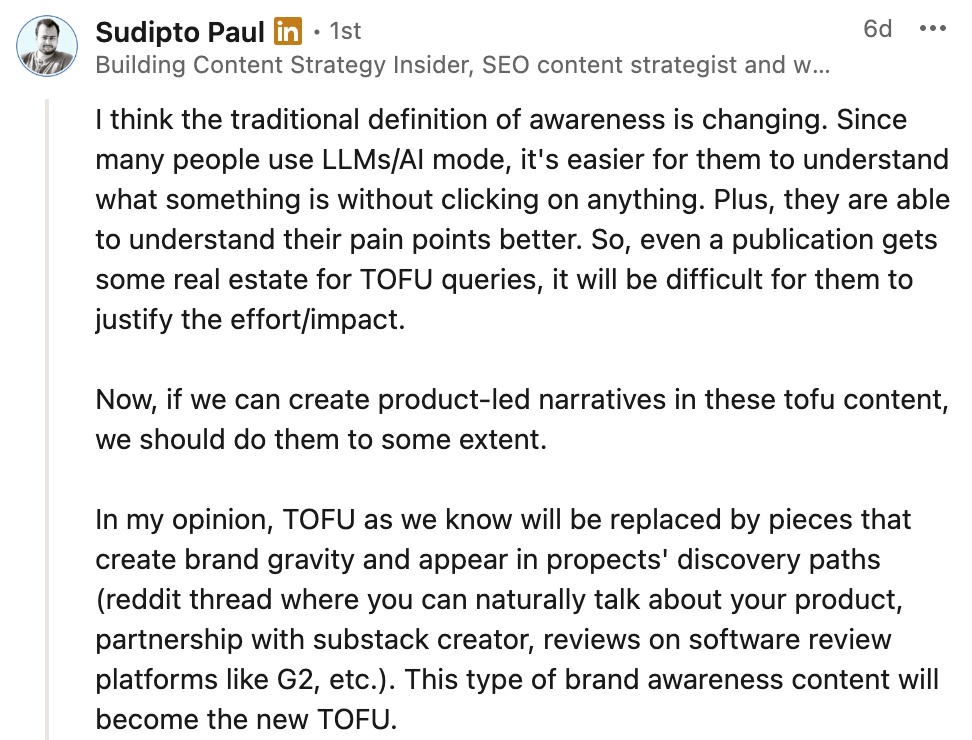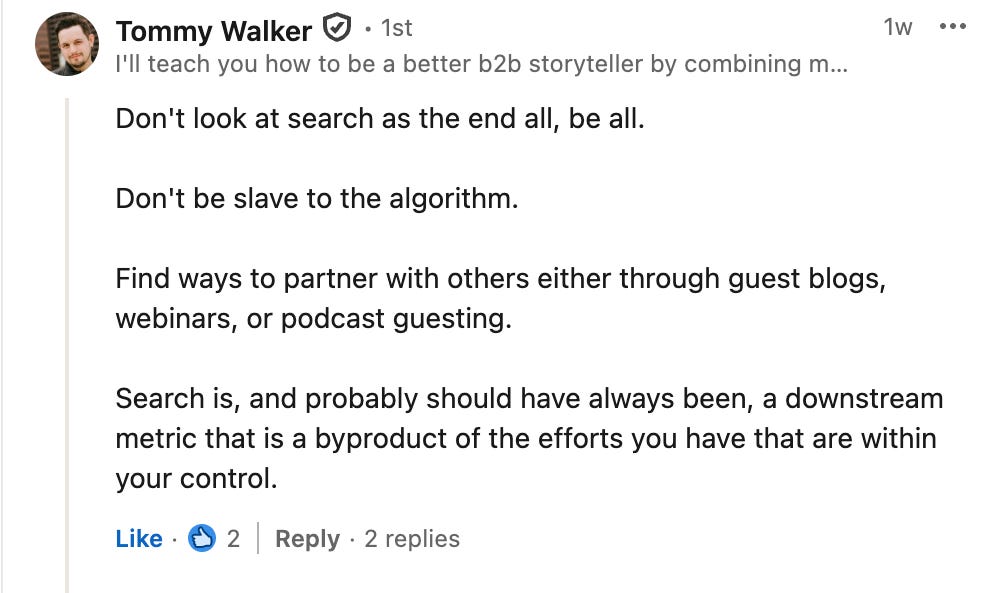If you’re still doing ToFu the old way, you’re already invisible.
How I’m rethinking ToFu in the age of AI, social search, and zero-click results.

When I first joined the content industry as a writer, most of the briefs I got were ToFu pieces — the plain old awareness-driven “what is” articles.
The idea was straightforward: to enhance brand awareness and provide readers with an in-depth understanding of a subject.
For years, this worked. Companies churned out endless “what is” articles, ranked on Google, and waited for traffic to roll in.
But try that today. Search for “what is content marketing,” and here’s what you’ll see:
At the very top sits Google’s AI Overview — a clean, consolidated answer stitched together from multiple sources. It even lets you dive deeper without ever leaving the search results.
Now, be honest — after reading that, what are the chances someone scrolls down and clicks a website?
Slim to none.
That’s why clicks on ToFu pieces have dropped sharply. Impressions go up, but clicks go down — a problem we’re seeing everywhere.
The old top-of-funnel playbook, writing keyword-stuffed blogs and waiting for Google to send traffic, doesn’t work anymore.
People aren’t just “searching” on Google. They’re discovering answers on TikTok, learning from industry newsletters, debating on Reddit, and increasingly trusting AI-curated summaries over clicking through to websites.
If your ToFu strategy only serves Google, you’re invisible everywhere else.
This is where the new ToFu comes in: content built for discovery, not just search.

Before diving deep, let’s first understand what ToFu is.
ToFu stands for Top-of-Funnel — the content you create to attract and educate people at the very beginning of their journey.
It’s not about selling. It’s about introducing a problem, sparking curiosity, and building awareness of your brand.
Traditionally, ToFu content has looked like:
- Educational blog posts: “What is content marketing?”, “Top 10 Instagram growth hacks.”
- Explainer videos & infographics: Breaking down complex ideas into simple visuals.
- Social media posts & podcasts: Casting a wide net to reach new audiences.
Its job? To get people in the door.
The problem? That door has moved.
What’s changed: Search intent + user behavior
The old TOFU playbook was simple:
Write an SEO-optimized blog → rank on Google → capture traffic.
However, that formula is broken because the way people search, discover, and trust content has undergone a fundamental shift.
1. AI is answering before websites do.
Google’s AI Overviews consolidate information from multiple sources and present it directly on the search page.
- What this means: Users don’t need to click through anymore — they get their answer instantly.
- The impact: Even if your content ranks, fewer people are reaching your site. This is why zero-click searches now account for the majority of queries.
2. Social platforms are becoming the new search engines.
TikTok, LinkedIn, and Reddit are increasingly where people go to ask questions, find recommendations, and learn through bite-sized, experience-driven content.
- For younger audiences: TikTok, Instagram, and YouTube have overtaken Google as the starting point for search in many cases (e.g., “best productivity apps,” “how to grow on Instagram”).
- For B2B: LinkedIn posts, X threads, and niche newsletters are trusted more than generic search results.
Even most LLMs like ChatGPT and Claude are pulling insights directly from platforms like Reddit. Why? Because Reddit threads are often real conversations, packed with first-hand experiences, nuanced opinions, and context that traditional blog content often lacks.

3. Communities are the new knowledge hubs.
People now prefer interactive discovery over static articles. They join Slack groups, Discord servers, and Substack communities where they can get answers, advice, and context directly from peers and experts.
4. Search intent itself has evolved.
Searchers don’t just want “what is” answers — they want nuanced, contextual, and opinionated content that feels human. They’re looking for lived experiences, case studies, and frameworks, not just definitions.
So how do you go with this shift?
Alright, how do you ToFu in 2025?
If your audience is now finding answers through AI tools, social feeds, and community conversations, your ToFu approach can’t just be about hitting “publish” and hoping search traffic follows. You need to create content that’s designed to travel — and be discovered — from the start.
Here’s my A.I.M.E. framework for building discovery-first ToFu:
A – Audit
Start by spotting the content that’s losing momentum. That might be:
- Posts that still get impressions but see fewer clicks.
- Pieces built around outdated examples or stats.
- Topics where competitors are now showing up higher in AI summaries, on LinkedIn, or in niche forums.
I – Innovate
Breathe new life into these assets:
- Add a unique perspective, story, or contrarian take that can’t be replicated by a generic AI answer.
- Adapt the same idea into formats that thrive on different platforms — from LinkedIn carousels to quick TikTok explainers to discussion prompts in communities.
- Don’t fall into the trap of creating purely to please an algorithm — aim to be genuinely useful and memorable.
M – Mobilize
Make sure your content doesn’t just sit in one place. Get it in front of people where they already spend time:
- Publish in AI-friendly formats that help it surface in overviews.
- Share on social search platforms like LinkedIn, TikTok, and YouTube Shorts.
- Join the conversations happening in Reddit threads, Slack groups, Discord servers, and niche newsletters.
- Look beyond your own channels — team up with others through guest articles, joint webinars, or podcast appearances to tap into audiences that already trust them.

E – Evaluate
Judge success on more than just visits from Google. Pay attention to:
- Comments, shares, and saves.
- Organic mentions in forums or social discussions.
- Whether people remember and repeat your key points weeks later.
The real shift is in mindset: visibility in search should be the outcome, not the only objective. When you create content people actively want to share, cite, and discuss, Google rankings often follow as a side effect — but your reach won’t depend on them.
The goal: Build content that creates pull — the kind that sticks in people’s minds and shows up naturally in the places they go to learn.
Bye…👋
The way people discover information has changed forever — and so must our approach to ToFu.
Google rankings and search clicks still have their place, but they can’t be the only finish line you aim for.
The brands winning today are the ones showing up in AI summaries, algorithm-driven feeds, and real community conversations — not just in the SERPs.
That’s the promise of the A.I.M.E. framework: start with what you already have, reimagine it for multiple discovery paths, put it where your audience actually spends time, and measure the impact in ways that go beyond traffic charts.
If your ToFu content creates curiosity, earns trust, and sticks in people’s minds, you won’t need to chase clicks — they’ll follow naturally.
So here’s your challenge: pick one piece of content this week and run it through A.I.M.E. You might be surprised how far it travels when it’s built for discovery, not just search.
That’s it for this edition. I’m Charu — a content marketer who’s obsessed with building strategies that actually work in the AI era. I share what I’m learning (and unlearning) as I experiment with growth, storytelling, and new discovery channels.
See you in the next one 👋
Sponsor CopyStash: Reach 500+ growth-focused marketers, founders, and creators who care about content, marketing, and business growth.